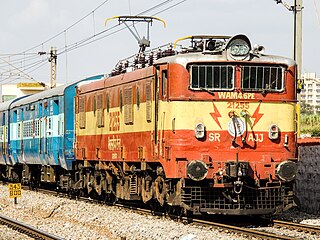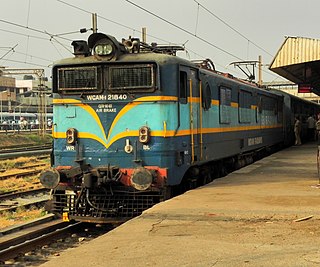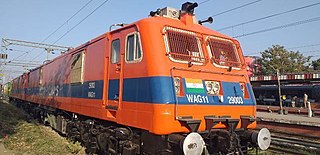
The Indian locomotive class WAP-4 is a class of 25 kV AC electric locomotives that was developed in 1993 by Chittaranjan Locomotive Works for Indian Railways. The model name stands for broad gauge (W), AC Current (A), Passenger traffic (P) locomotive, 4th generation (4). They entered service in late 1994. A total of 778 WAP-4 were built at CLW between 1993 and 2015, which made them the most numerous class of mainline electric passenger locomotive until the WAP-7.

The Indian locomotive class WAG-5 is a class of 25 kV AC electric locomotives that was developed in 1978 by Chittaranjan Locomotive Works for Indian Railways. The model name stands for broad gauge (W), alternating current (A), goods traffic (G) engine, 5th generation (5). They entered service in 1980. A total of 1196 WAG-5 were built at CLW and BHEL between 1978 and 1998, which made them the most numerous class of mainline electric locomotive until the introduction of its successor, the WAG-7.

The Indian locomotive class WAM-4 is a class of 25 kV AC electric locomotives that was developed in 1970 by Chittaranjan Locomotive Works for Indian Railways. The model name stands for broad gauge (W), alternating current (A), mixed traffic (M) locomotive, 4th generation (4). They entered service in March 1971. A total of 500 WAM-4 were built at CLW between 1970 and 1983, which made them the most numerous class of mainline electric locomotive till its successor the WAG-5.

The Indian locomotive class WCAM-1 was a class of dual-voltage electric locomotives that was developed in 1973 by Chittaranjan Locomotive Works for Indian Railways. The model name stands for broad gauge (W), DC Current (C), AC Current (A), Mixed traffic (M) locomotive, 1st generation (1). They entered service in March 1973. A total of 53 WCAM-1 were built at CLW between 1973 and 1979, which made them the most numerous class of mainline dual-power AC-DC electric locomotive.

The Indian locomotive class WCAM-2 is a class of dual-power AC/DC series electric locomotives that was developed in 1995 by Bharat Heavy Electricals Limited used in the Indian Railways system. They are the second locomotive from the WCAM class. The model name stands for broad gauge (W), DC Current (C), AC Current (A), Mixed traffic (M) locomotive, 2nd generation (2). They entered service in 1995. A total of 20 WCAM-2 were built at BHEL between 1995 and 1996, which made them the most numerous class of mainline dual-power AC-DC electric locomotive. They use the same motors as WCAM 1 but with different circuitry and gearing. They are operational in routes around Mumbai. MU operation was possible with 3 units. WCAM-2P was the passenger-oriented version of the WCAM-2 class. However, they perform better than the WCAM 1 series.

The Indian locomotive class YAM-1 is a class of metre gauge (Y), Alternating Current (A), mixed traffic (M) electric locomotives in India. Twenty were built in 1964–66 by a Japanese consortium led by Mitsubishi.

The Indian locomotive class WCAM–3 is a class of dual-power AC/DC series electric locomotives That was developed in 1997 by Bharat Heavy Electricals Limited used in the Indian Railways system. They are the third locomotives from the WCAM class. The model name stands for broad gauge (W), DC Current (C), AC Current (A), Mixed traffic (M) locomotive, 3rd generation (3). They entered service in 1997. A total of 53 WCAM-3 were built at BHEL between 1997 and 1998, which made them the most numerous class of mainline dual-power AC-DC electric locomotive. They were specifically designed for use by Central Railways in the Ghat section towards Nashik and Pune.

The BB 13000 class were electric locomotives operated by SNCF in France. They were one of four classes, together with the BB 12000, CC 14000 and CC 14100 classes, that formed an experimental group for studying the practicality of the new French 25 kV 50 Hz AC electrification.

The Indian locomotive class WCG-2 is a class of 1.5 kV DC electric locomotives that was developed in the late 1960s by Research Design and Standards Organisation (RDSO) and Chittaranjan Locomotive Works (CLW) for Indian Railways. The model name stands for broad gauge (W), DC Current (C), Goods traffic (G) engine, 2nd generation (2). They entered service in February 1971. A total of 57 WCG-2 were built at CLW between 1978 and 1983, which made them the most numerous class of DC electric locomotive.

The Indian locomotive class WAM-1 was a class of 25 kV AC electric locomotives that was developed in the late 1950s by the Groupement 50Hz for Indian Railways. The model name stands for broad gauge (W), AC Current (A), Mixed traffic (M) locomotive, 1st generation (1). They entered service in 1960, thus making them the first AC electric locomotives to be in service in India. A total of 100 WAM-1s were built by the European consortium between 1959 and 1961, which made them the most numerous class of mainline electric locomotive until the WAG-1.

The Indian locomotive classes WAM-2 and WAM-3 were 25 kV AC electric locomotives that were imported from Japan in the 1960s for Indian Railways. The model name stands for broad gauge (W), AC Current (A), Mixed traffic (M) locomotive, 2nd generation (2). A total of 38 WAM-2/3 locomotives were built by the Japanese Group between 1960 and 1964. They entered service in 1960.
The Indian locomotive class WCAG–1 is a class of dual-power AC/DC series locomotives used in the Indian Railways system. They are the only class of the WCAG locomotives. They were specifically designed for use by Central Railways in the Ghat section towards Nashik and Pune.

The Indian locomotive class WAG-11 is a class of twin-section 25 kV AC electric locomotives that was developed in 2018 by Banaras Locomotive Works (BLW), Varanasi for Indian Railways. This freight engine has been designed for a speed of 105 km/h and weighs 252 tons. It is equipped with a three-phase induction motor, four power converters and regenerative as well as pneumatic braking system. The model name stands for broad gauge (W), Alternating Current (A), Goods traffic (G), and 11th in series (11). They entered trials service in 2019. A total of 4 WAG-11 pairs have been built by Banaras Locomotive Works (BLW), Varanasi.
The Indian locomotive class WCM-3 was a class of 3 kV DC, later 1.5 kV DC electric locomotives that were developed in 1958 by Hitachi for Indian Railways. The model name stands for broad gauge (W), Direct Current (C), Mixed traffic (M) engine, 3rd generation (3). They entered service in 1958. A total of 3 WCM-3 locomotives were built in Japan in 1958.

The Indian locomotive class WAG-1 was a class of 25 kV AC electric locomotives that was imported from Europe in the 1960s for Indian Railways. The model name stands for broad gauge (W), AC Current (A), Goods traffic (G) locomotive, 1st generation (1). A total of 112 WAG-1 were built by The European Group 50 Hz Group/European Group/50 Cycles Group (consortium) between 1963 and 1966. They entered service in 1964.
The Indian locomotive class WAG-3 was a class of 25 kV AC electric locomotives that was imported from Europe in the mid 1960s for Indian Railways. The model name stands for broad gauge (W), AC Current (A), Goods traffic (G) engine, 3rd (3). A total of 10 WAG-3 locomotives were built by The European Group 50 Hz Group/European Group/50 Cycles Group (consortium) in 1965, and entering service in the same year.

The Indian locomotive class WAG-4 is a class of 25 kV AC electric locomotives that was manufactured by CLW in the late 1960s for Indian Railways. The model name stands for broad gauge (W), AC Current (A), Goods traffic (G) engine, 1st (1). A total of 186 WAG-4 locomotives were built by The European Group 50 Hz Group/European Group/50 Cycles Group (consortium) between 1967 and 1969. They entered service in 1967.

The Indian locomotive class WAG-6A is a class of 25 kV AC electric locomotives that was developed in the 1988 by Allmänna Svenska Elektriska Aktiebolaget (ASEA) for Indian Railways. The model name stands for broad gauge (W), AC Current (A), Goods (G) engine, 6th generation (6) First variant (A). They entered service in 1988. A total of 6 WAG-6A were built at ASEA, Sweden between 1987 and 1988. they were the most powerful locomotives in India until the arrival of the WAG-9 class.
The Indian locomotive class WAG-8 was a class of 25 kV AC electric locomotives that was developed in the early 1990s by Bharat Heavy Electricals Limited (BHEL) for Indian Railways. The model name stands for broad gauge (W), AC current (A), freight/goods traffic (G), eighth-generation (8). Only two units of this class were built, both prototypes.

The Indian locomotive class WAG-6B/C is a class of 25 kV AC electric locomotives that was developed in the 1988 by Hitachi for Indian Railways. The model name stands for broad gauge (W), AC Current (A), Goods (G) engine, 6th generation (6) Second/Third variant (B/C). They entered service in 1988. A total of 12 WAG-6 were built at Hitachi, Japan between 1987 and 1988. they along with WAG-6A were the most powerful locomotives in India until the arrival of the WAG-9 class.




















